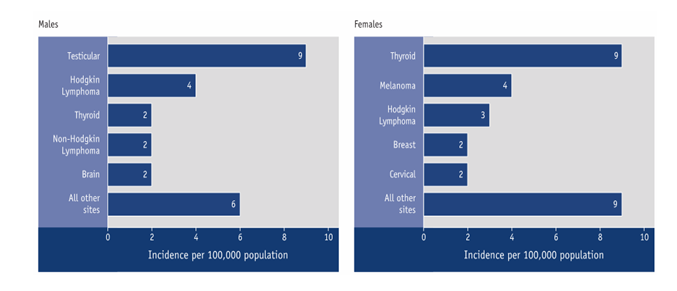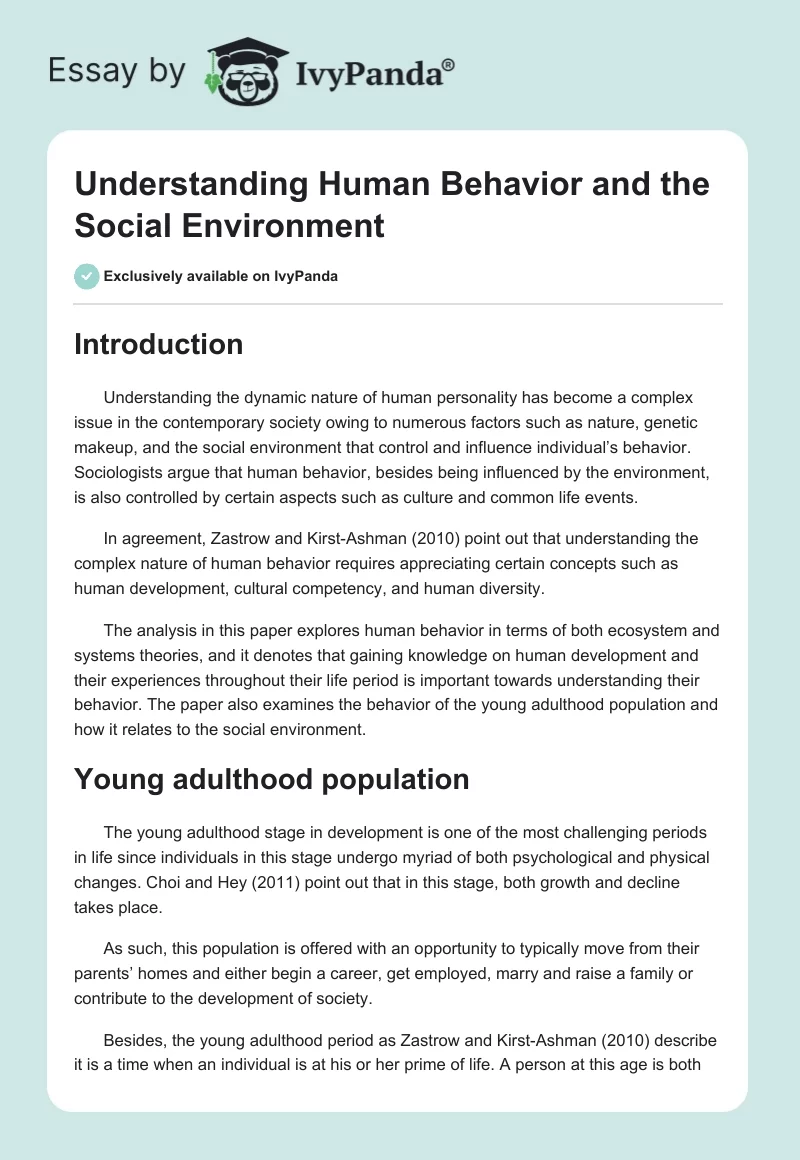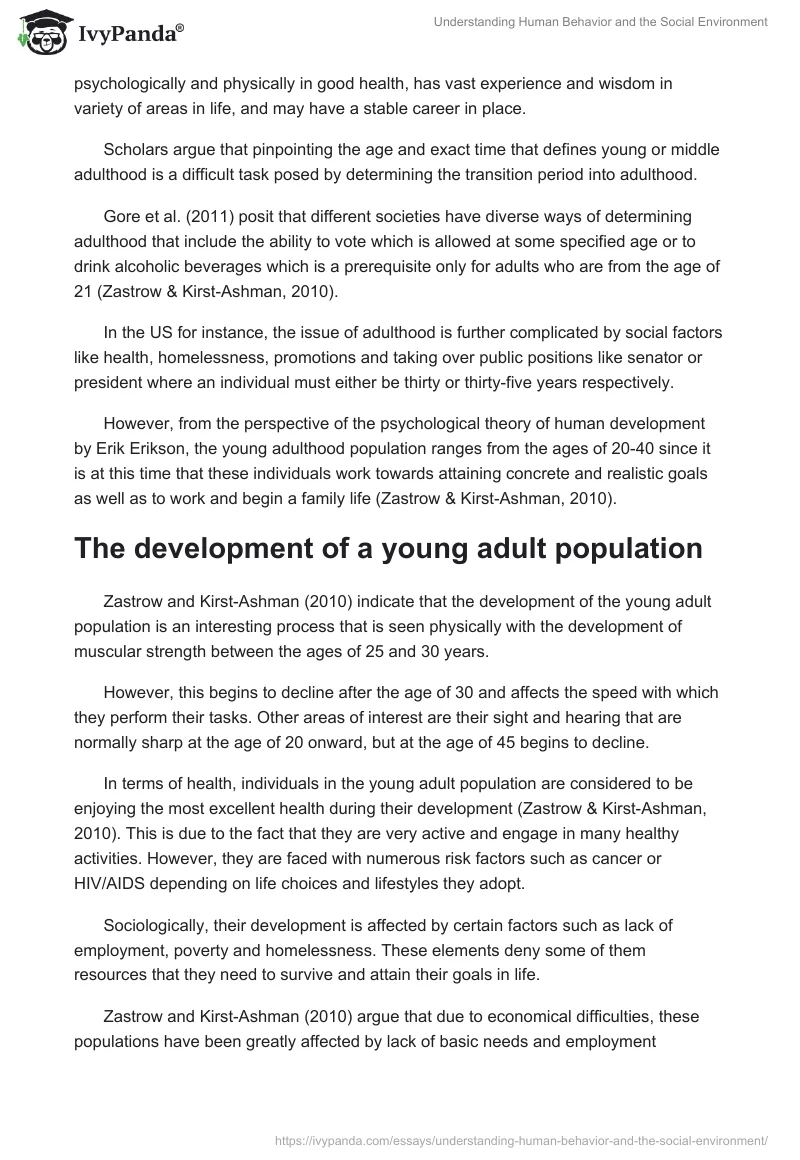Introduction
Understanding the dynamic nature of human personality has become a complex issue in the contemporary society owing to numerous factors such as nature, genetic makeup, and the social environment that control and influence individual’s behavior. Sociologists argue that human behavior, besides being influenced by the environment, is also controlled by certain aspects such as culture and common life events.
In agreement, Zastrow and Kirst-Ashman (2010) point out that understanding the complex nature of human behavior requires appreciating certain concepts such as human development, cultural competency, and human diversity.
The analysis in this paper explores human behavior in terms of both ecosystem and systems theories, and it denotes that gaining knowledge on human development and their experiences throughout their life period is important towards understanding their behavior. The paper also examines the behavior of the young adulthood population and how it relates to the social environment.
Young adulthood population
The young adulthood stage in development is one of the most challenging periods in life since individuals in this stage undergo myriad of both psychological and physical changes. Choi and Hey (2011) point out that in this stage, both growth and decline takes place.
As such, this population is offered with an opportunity to typically move from their parents’ homes and either begin a career, get employed, marry and raise a family or contribute to the development of society.
Besides, the young adulthood period as Zastrow and Kirst-Ashman (2010) describe it is a time when an individual is at his or her prime of life. A person at this age is both psychologically and physically in good health, has vast experience and wisdom in variety of areas in life, and may have a stable career in place.
Scholars argue that pinpointing the age and exact time that defines young or middle adulthood is a difficult task posed by determining the transition period into adulthood.
Gore et al. (2011) posit that different societies have diverse ways of determining adulthood that include the ability to vote which is allowed at some specified age or to drink alcoholic beverages which is a prerequisite only for adults who are from the age of 21 (Zastrow & Kirst-Ashman, 2010).
In the US for instance, the issue of adulthood is further complicated by social factors like health, homelessness, promotions and taking over public positions like senator or president where an individual must either be thirty or thirty-five years respectively.
However, from the perspective of the psychological theory of human development by Erik Erikson, the young adulthood population ranges from the ages of 20-40 since it is at this time that these individuals work towards attaining concrete and realistic goals as well as to work and begin a family life (Zastrow & Kirst-Ashman, 2010).
The development of a young adult population
Zastrow and Kirst-Ashman (2010) indicate that the development of the young adult population is an interesting process that is seen physically with the development of muscular strength between the ages of 25 and 30 years.
However, this begins to decline after the age of 30 and affects the speed with which they perform their tasks. Other areas of interest are their sight and hearing that are normally sharp at the age of 20 onward, but at the age of 45 begins to decline.
In terms of health, individuals in the young adult population are considered to be enjoying the most excellent health during their development (Zastrow & Kirst-Ashman, 2010). This is due to the fact that they are very active and engage in many healthy activities. However, they are faced with numerous risk factors such as cancer or HIV/AIDS depending on life choices and lifestyles they adopt.
Sociologically, their development is affected by certain factors such as lack of employment, poverty and homelessness. These elements deny some of them resources that they need to survive and attain their goals in life.
Zastrow and Kirst-Ashman (2010) argue that due to economical difficulties, these populations have been greatly affected by lack of basic needs and employment opportunities making some of them to delay or completely fail to make contributions in the society of even marry and raise families.
Cancer and homelessness as major issues affecting this population and influencing their behavior
Cancer
Statistics indicate that in the US, the number of young adults diagnosed with cancer each year is approximately 70,000 (Zastrow & Kirst-Ashman, 2010). The rate of diagnosis of cancer among individuals of ages 15-40 in many nations in the world is almost eight times that of individuals under the age of fifteen.
In his publication, Song and Ling (2011) point out that cancer among the young adult population has been a distressing issue that has posed threat towards maintaining good health and achieving their goals in life. As a terminal infection, cancer is known to affect the body cells adversely.
The prevalence of cancer in this population and especially breast cancer has been of great concern to both the general population and health authorities in many nations of the world.
Figure 1: A graph representing the population of young adults with cancer

Zastrow and Kirst-Ashman (2010) argues that cancer is the major killer disease among the young adult population of ages 20-39 years. The social, economic, and personal costs associated with the diagnosis and treatment of this disease is rather high.
Besides, the impact that cancer has on the development of a person in this stage and the realization of goals in life is devastating. Among many young people, individuals who are at risk vary depending on the type of cancer. Some types of cancers can be found in both young and older adults.
For instance, skin cancer affects all age groups. However, the risk is greater in older people, those who have been diagnosed with melanoma or may depend on the medical history of their families, those who are immune-suppressed, light-skinned individuals, and those who are exposed to ultraviolet radiations (UVR) (Zastrow & Kirst-Ashman, 2010).
Figure 2: A graph representing population of young adults and the types of cancer affecting them

However, the absolute risk of developing breast cancer is lower in young adult women than in old women. Song and Ling (2011) point out that the older an individual grows, the higher the chances of developing breast cancer.
Homelessness
The problem of homelessness among the young adult population has indeed become a complex issue in society today and has caused individuals and families great grief as individuals exposed to it are likely to engage in criminal activities, substance abuse other related things common among the homeless. In the article Freidenberg (2011) argues that the number of homeless young population in the world today is growing at an alarming rate.
He attributes it to lack of affordable housing, natural disasters, housing problems, abuse and unemployment among other issues. In agreement, studies indicate that most of the homeless individuals in the streets blame their condition to high cost of housing, poor health conditions, addiction and lack of income (Zastrow & kirst-Ashman, 2010).
Routines
To begin with, Thornton, Ryckman and Gold (2011) use social adaptation approach to argue that long exposure of young adult population to homelessness due to inability of the government or concerned bodies to intervene for them and provide assistance is likely to lead the young adult population into developing particular routines such as involvement in criminal activities and other related evils.
The state of homelessness and acceptance of their state may also deny them the ability to work harder and attain their objectives in life. Instead, this acceptance may make them develop a routine that is common among the homeless of living and eating from the streets.
They further argue that the environment in which a homeless young adult person live can greatly affect there general health and wellness in the sense that it undermines their self-esteem as it causes a decline in their physical appearances (Thornton, Ryckman and Gold, 2011).
Subsistent strategies
Besides routine, Freidenberg (2011) points out that the young adult populations faced with homeless may involve themselves in substance abuse as survival strategies and means of comfort and acceptance of their situation.
Basing this argument on ecological systems theory, Bronfenbrenner indicates that due to the nature of difficulties posed by being homeless, destitute individuals have developed learning strategies of coping with and surviving homelessness (Freidenberg, 2011).
Living in a stressful environment and the need to cope with its difficulties pushes them to substances use. For instance, substance abuse as a strategy to adapt to lack of job and homelessness has become one of the modes with which the young adult individuals indicate acceptance of their state (Thornton, Ryckman and Gold, 2011).
Role of family and response to selected conditions
Sociological perspectives
The way individuals and families view issues happening in the social world largely depends on the different perspectives provided by theories in sociology. However, studies indicate that most families are unaware of or simply neglect their role of motivating and supporting the young adult population (Zastrow & Kirst-Ashman, 2010).
A set of designed principles and interrelated propositions can provide perspectives on a particular phenomenon give answers to questions and help families to understand issues affecting the young adult individuals as well as the society they are living in.
Families of the young adult population should assist them to be able to comfortably cope with issues that affect them socially and overcome hurdles and crises common in their stage of development.
Barry and Piazza (2011) point out that since many life crises occur and affect individuals in the midlife periods, parents, relatives, friends and the society should provide advice, guidance and answers to this population for purposes of encouraging and motivating them.
On matters relating to health issues like cancer and its epidemiology among the young adult population, terms such as functional and dysfunctional are frequently applied their effects with the latter referring to issues disrupting the stability of the society.
Choi and Hey (2011) point out that health issues like cancer and menopause and their effects in terms of injury and mortality among young people greatly affect the development of this population.
Inasmuch as health issues can be termed as dysfunctional aspects, they may also contribute to social stability. In this sense, health injuries and mortality can be functional aspects that contribute to increased social cohesion and creation of awareness.
Furthermore, Marx uses the conflicting perspective to elaborate more on economic inequalities and competing values and interest in the society. From his perspective, it is evident that young adult people, especially the female population who are in terrible afflictions due to breast cancer may feel a sense of meaninglessness, alienation or powerlessness due to their illnesses or poor conditions (Zastrow & Kirst-Ashman, 2010).
Organizations and groups that impact on these populations
Borrowing from the perspective of the structural-functionalist theory by Talcott Parsons, organizations and groups in the society today play a significant role in creating social balance, a state of equilibrium, harmony and various interconnecting aspects of the society (Barry& Piazza, 2011).
Among individuals in the young adult population, different social institutions such as religious groups, families, political groups and economic societies play key roles of empowering them and providing them with education where they gain knowledge and skills to help them advance in the society.
Economically, the government also plays a role in creating job opportunities for them. This, in turn, enhances their purchasing power and provides them with income and other related resources to attain their goals in life.
Emile Durkheim, influenced by the philosophies of Comte, Rousseau and Voltaire, argues in his functionalistic theory that the behavior of individuals and their necessities are determined by social configurations. Indeed, from social cohesion and social exclusion perspective, issues like poverty and illness may deny the young adult population the chance to get social acceptance they need.
Without adequate resources to support this population and jobs to sustain them, they may end up being homeless or sick and may, therefore, end up being excluded. Fettes and Aarons (2011) point out that there is need for governments to develop social policies whose goals will be to ensure survival to everyone by availing necessary resources in this competitive society.
In using structural-functionalist perspective to relate the theories of Karl Marx and Emile Durkheim on social pathology and social disorganization, it is imperative to point out that human behavior or patterns of action are greatly influenced by the environment in which he or she lives in (Zastrow & Kirst-Ashman, 2010
Consequences of diversity, discrimination, and oppression of these groups
All forms of social injustices, as well as diversity, massively impacts negatively on the lives of the young adult population and this may lead to them adopting certain characteristics or behaviors that may impact on the whole society.
According to Gore et al. (2011), due to lack of social justice, individuals in the young adult stage who are homeless are normally marginalized as underclass people, and are thus made to form part of the fringe in the society.
This kind of exclusion has likely effects of depression on marginalized individuals. One of the most common faces of depression exhibited by the young adult homeless individuals is acceptance. Many homeless individuals accept their helplessness and in their depression, adopt certain behaviors that relate to their condition and need for survival.
Revelers for social work
David Howe indicates in his theory of social works that in dealing with the issues affecting society, there is need to identify the problem and provide an effective solution depending on the level of the problem. Among individuals in the young adult population, empowerment is an important factor in eradicating social problems that impact on their behavior (Zastrow & Kirst-Ashman, 2010).
In addition, empowerment in health promotion by health organizations will enable these populations, individuals or groups to mobilize resources, both material and human, and use them to protect and promote their health.
In order to curb health issues like AIDS and cancer, health activists and health workers should work together in ensuring that the public policies affecting health are shaped through supporting access to the political processes, facilitate skills development and provide access to information on health.
Moreover, there is need for the government and health care centers to ensure equity in health provision among populations. Distribution of resources and opportunities in a nation should be guided by peoples’ needs. Achieving greater equity in health within and between populations and countries is a strategy which according to WHO, works so well in achieving health for every person (Zastrow & Kirst-Ashman, 2010).
Conclusion
To sum up, the discussion in this paper was based on the thesis statement “understanding the dynamic nature of human personality has today become a complex issue owing to the numerous factors such as nature, genetic makeup and the social environment that control and influence a person’s behavior”.
From the analysis, it is evident that human behavior may be controlled by events happening within the social environment. Young adults are faced with numerous life crises that greatly and negatively impact on their development.
References
Barry, A. & Piazza, A. (2011). Should Exercise Be Promoted as an Effective Intervention Strategy to Off-Set Excessive College Student Drinking? Journal of American College Health, 59(3), 139-140.
Choi, S. & Hey, J. (2011). Joint inference of population assignment and demographic history. Genetics, 189(2), 561-577.
Fettes, D. & Aarons, G. (2011). Smoking behavior of US youths: A comparison between child welfare system and community populations. American Journal of Public Health, 101(12), 2342-2348.
Freidenberg, J. (2011). Researching global spaces ethnographically: queries on methods for the study of virtual populations. Human Organization, 70(3), 265- 278.
Gore et al. (2011). Global burden of disease in young people aged 10-24 years: a systematic analysis. The Lancet, 377(9783), 2093-2102.
Song, A. & Ling, P. (2011). Social smoking among young adults: investigation of intentions and attempts to quit. American Journal of Public Health, 101(7), 1291- 1296.
Thornton, B., Ryckman, R. & Gold, J. (2011). Competitive orientations and the type a behavior pattern. Psychology, 2(5), 411-415.
Zastrow, C. & Kirst-Ashman K. (2010). Understanding human behavior and the social environment. New York: Cengage Learning.


